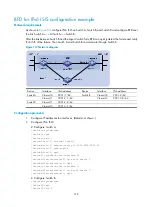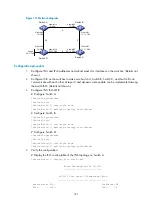
327
Step Command
Remarks
4.
Specify the source interface
for establishing TCP
connections to an IPv6 BGP
peer or peer group.
peer
{
ipv6-group-name
|
ipv6-address
}
connect-interface
interface-type
interface-number
By default, IPv6 BGP uses the
outbound interface of the best
route to the IPv6 BGP peer or peer
group as the source interface for
establishing a TCP connection.
Allowing the establishment of an indirect EBGP connection
Direct links must be available between EBGP peers. If not, you can use the
peer ebgp-max-hop
command to establish a multi-hop TCP connection in between. However, do not use this command for
direct EBGP connections with loopback interfaces.
To allow the establishment of a non-direct EBGP connection:
Step Command
Remarks
1.
Enter system view.
system-view
N/A
2.
Enter BGP view.
bgp
as-number
N/A
3.
Enter IPv6 address family view.
ipv6-family
N/A
4.
Allow the establishment of EBGP
connection to an indirectly connected peer
or peer group.
peer
{
ipv6-group-name
|
ipv6-address
}
ebgp-max-hop
[
hop-count
]
Not configured by
default.
Configuring a description for an IPv6 peer or peer group
Step Command
Remarks
1.
Enter system view.
system-view
N/A
2.
Enter BGP view.
bgp
as-number
N/A
3.
Enter IPv6 address family
view.
ipv6-family
N/A
4.
Configure a description for an
IPv6 peer or peer group.
peer
{
ipv6-group-name
|
ipv6-address
}
description
description-text
Optional.
Not configured by default.
The peer group to be
configured with a
description must have been
created.
Disabling session establishment to an IPv6 peer or peer group
Step Command
Remarks
1.
Enter system view.
system-view
N/A
2.
Enter BGP view.
bgp
as-number
N/A






























